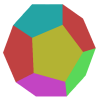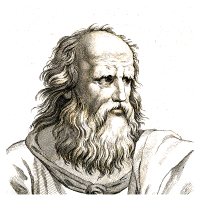The game
- Tetrahedron
- Cube
- Octohedron
- Dodecahedron
- Icosahedron
Gameplay is simple, swipe the screen to rotate the solid, touch a face of the solid to change its colour. Each face of the solid is linked to another and when it is touched, both faces change colour. The aim of the game is to turn all the faces of the solid the same colour as quickly and in as few moves as possible. Each individual game has its own 'par' value. This is the number of turns that you can definitey complete the puzzle in, but not nescessarily the least number. In fact, in most cases, it is possible to complete the puzzle in fewer than 'par' turns. The games are scored by the number of turns under or over par and/or the time taken.
There are three main types of game, training games, random games and challenge games. Each type of game can be played with each solid.
Training games
Training games are a set of six games which start simple and become progressively more difficult. The starting conditions for these games are fixed so that any one game on any one solid will always follow the same course. These games are designed to allow the player to get used to the solids and the gameplay.
Random games
Random games are the main game. For each game the starting conditions are set randonly. Because these games are set randomly, some are harder than others.
Challenge games
Challenge games each have slightly different starting points, gameplay, or endpoints. there are six challenge games for each solid, ranging in difficulty from simple to extremely hard.
- Traffic Lights
- Go from red to yellow to green. All the faces start red, your aim is to make them first all yellow and then all green. Extremely simple
- Green for Go
- Turn the solid green. Start with random colours and change all faces to green. Normal difficulty
- Backtrack
- Do you know your solids backwards. This is a random game, however the links between the faces are reversed. Slightly harder than normal
- Colour Shakeup
- Lets shuffle the colours. This is again a random game, but each with a new and random sequence of colours. Quite hard.
- Difference
- If they share an edge, different colours. In this game, the endpoint is different. Your aim is make all the neigbouring faces a different colour using as few colours as possible (see the four colour theorem). Quite hard.
- Threeway
- This time three sides change at once. In this game the aim is again to make all the faces the same colour, however this time, in addition to its nnormal link, each face is also linked to one additional random neigbour. All three faces change at the same time.


